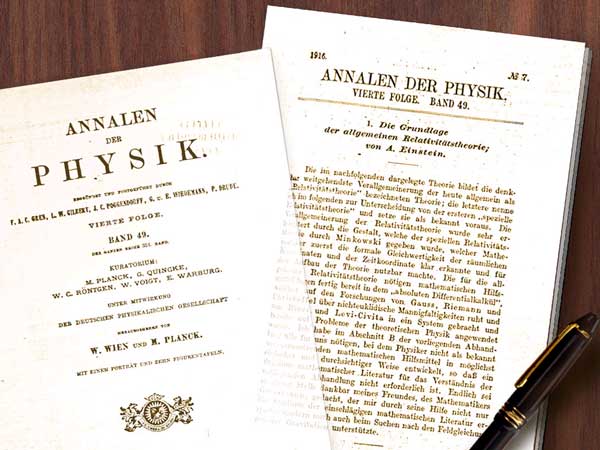Edward Hessler
On 2 December 2015 is marked the 100th year of the publication by Albert Einstein of the General Theory of Relativity. A mere four pages.
In the introduction to a special issue of the journal Science noting this achievement, Margaret Moerchen and Robert Coontz take care to point out the general practice of scientists, a contrast to Einstein's singular accomplishment.
The way we think science is done is not the usual way it is done except in a very few cases. To paraphrase a song made popular by Frank Sinatra, Einstein did it "his way."What he did, "his way," was develop the theory alone.
However, science requires something not done alone: empirical scientific evidence provided by other scientists. One check after another; one check leading to another. And so on. So far, general relativity has withstood the predictions it made. It is still being tested, a feature of the nature of science: hold things always in some state of doubt and test, re-test, etc.
Resources on General Relativity
You may find a "superquick, superpainless" guide to general relativity here. You are the judge on how quick and painless it is!
 |
| By Mundo de Hacker (Own work, investigacion de libros) [GFDL (http://www.gnu.org/copyleft/fdl.html) or CC BY 3.0 via Wikimedia Commons (http://creativecommons.org/licenses/by/3.0)], |
If you are interested in a carefully researched book on what Einstein said versus what he is purported to have said, Alice Calaprice's The New Quotable Einstein is invaluable. It is a joy to read and it is organized for reading--it is in chapters. There is a lovely introduction by Freeman Dyson who knew him well. Additions (400 of them) to this book are found in a revision--The Ultimate Quotable Einstein--but its content cannot be examined on-line as it can in the original.
It is easy to overlook the very difficult work the general theory of relativity required given our popular view of Einstein as a genius, especially as a mathematical genius. He was a genius and a very good mathematician but this theory didn't happen in one of those "Aha" moments. It took about a decade to develop. Today terms such as persistence and grit describe this grinding work.
Einstein didn't work alone
| By Dsmntl (Own work) [CC BY-SA 3.0 (http://creativecommons.org/licenses/by-sa/3.0) or GFDL (http://www.gnu.org/copyleft/fdl.html)], via Wikimedia Commons |
Over at BackReaction, theoretical physicist Sabine Hossenfelder writes about Einstein this way: So the historians pointing out that Einstein didn’t work in isolation, and that he met frequently with other researchers to discuss, do not give honor to the frustrating and often painful process of having to work through a calculation one doesn’t know how to do in the first place. It is evident from Einstein’s biography and publications that he spent years trying to find the right equations, working with a mathematical apparatus that was unfamiliar to most researchers back then. There was nobody who could have helped him trying to find the successful description that his intuition looked for.
(The blog entry linked to immediately above is about the idea of the "lone genius." It has a bonus. In it you will find a description of how a contemporary physicist--Robert Nemiroff, Michigan Technological University--goes about writing a paper. Confusion. Frustration. Cul-de-Sacs. Contradictions.)
Einstein had to to reinvent a considerable amount of mathematics with the help of a friend, Marcel Grossman. Einstein approached the task from many angles and used every available tool available to him: physical and intuitive. He made mistakes, took wrong turns (and sometimes even went backward), made guesses and developed ad hoc ideas to support them (later recognized as wrong) as well as used one thing he is noted for, the Gedankenexperiment. Here is one,
"I was sitting on a chair in my patent office in Bern (1907). Suddenly a thought struck me: if a man falls freely, he would not feel his weight. I was taken aback. This simple thought experiment made a deep impression on me. This led me to the theory of gravity."
Einstein's Life
 |
| By The original uploader was N2100 at Chinese Wikipedia [GFDL (http://www.gnu.org/copyleft/fdl.html) or CC-BY-SA-3.0 (http://creativecommons.org/licenses/by-sa/3.0/)], via Wikimedia Commons |
If you want to know more about Einstein's life and his contributions to physics there are two recent books. One is written thematically and the other chronologically. Here are two reviews of both books to help you make a choice. One is by Corey S. Powell and the other by Dennis Lythgoe.
The Guardian has a 2011 piece about general relativity that describes some of the relevance of the theory to us. And for a primer on general relativity see here.
UNESCO has designated 2015 as The International Year of Light, another take on the General Theory of Relativity.

 CGEE Student Voice
CGEE Student Voice
No comments:
Post a Comment